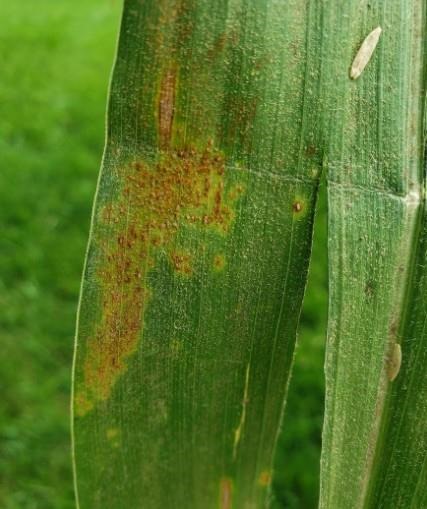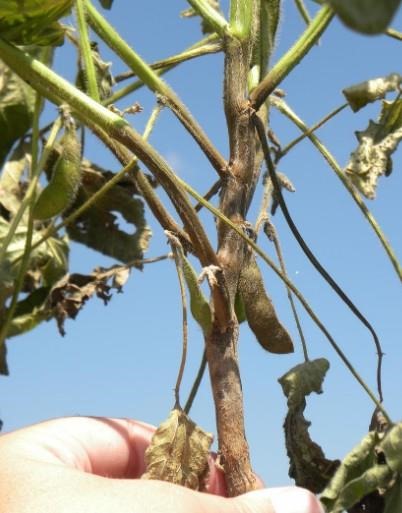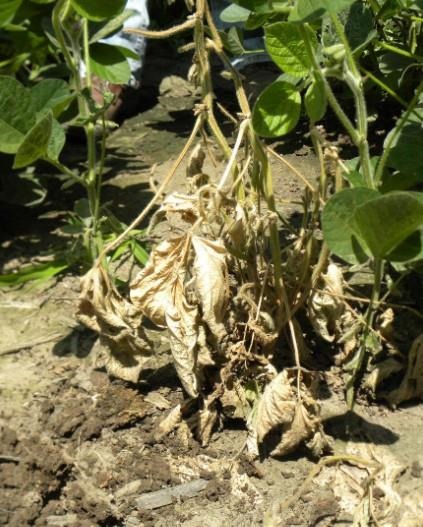By Tamra Jackson-Ziems
Corn
Southern Rust
Southern rust was confirmed on a corn leaf sample July 20 from Nemaha County in southeast Nebraska. Southern rust activity has increased in the southern states for a few weeks as very wet conditions persisted. Last week it was confirmed in eastern and central Kansas. Winds from the south will continue to move fungal spores into and throughout corn fields in Nebraska. We will likely see additional disease development and spread under the forecasted warm and humid conditions in the coming days. Corn fields, especially in southern Nebraska, should be scouted regularly to monitor for southern rust development and spread that may need to be treated with a foliar fungicide.
Southern rust pustules can be orange or tan in color and are mostly produced on the upper leaf surface (Figure 1). The fungus is favored by warm temperatures in the 80’s F and high relative humidity. In contrast, common rust pustules are dark brick red or cinnamon brown and usually larger than those of southern rust. Common rust pustules usually start on the upper leaf surface, but usually push through to the bottom to produce more spores there, as well. Cooler temperatures in the 70’s F are generally more favorable for common rust, so we generally see common rust development earlier in the season. Although, common rust is a lesser threat to field corn production as most hybrids have genetic resistance to the disease. On the other hand, fewer hybrids have resistance to southern rust, and under favorable conditions, the southern rust fungus can worsen and spread rapidly.
Watch the Southern Corn Rust – ipmPiPe site for updates.

Figure 1. Southern rust was confirmed on a corn sample this week submitted by Trevor Houghton and Bill McClure of Nemaha County, Nebraska.
Soybean
Phytophthora Root and Stem Rot
In spite of earlier dry weather conditions, Phytophthora root and stem rot (PRSR) has developed in some fields that received rain in recent weeks. The fungal-like organism causing PRSR, Phytophthora sojae, requires moisture to produce swimming zoospores that infect soybean roots. PRSR causes the most damage as a seedling disease, but can develop and kill plants throughout the entire system, differentiating it from other seedling diseases.
Identification — PRSR can cause plants to wilt, regardless of moisture availability, because it causes severe root rot. Affected plants may also have a prominent dark lesion on the lower stems (Figures 2a and 2b). Unfortunately, plant symptoms may also appear similar to those caused by the soybean gall midge. You can tell them apart by checking for the presence of root rot — a common symptom of PRSR — versus the presence of stem lesions containing the orange larvae of soybean gall midge. Differences in distribution may also help to tell them apart. PRSR can develop in single plants randomly scattered around the field or in low, wet areas, whereas soybean gall midge most often affects plants on the edges of fields.


Figures 2a and 2b. Phytophthora root and stem rot (PRSR) can cause severe root rot, wilting, and often development of a dark lesion near the bottom of the plant.
Management of PRSR can best be achieved by combining several available strategies:
- Use of soybean fungicide seed treatments specifically for PRSR control
- Note that products with mefenoxam or metalaxyl must be used at higher rates to control PRSR
- Variety selection
- Select varieties with one or more Rps genes for race-specific resistance, especially those with Rps3-a.
- You can also select varieties with the best PRSR field tolerance scores that provide additional control across multiple races
Frogeye Leaf Spot

Figure 3. Frogeye leaf spot has been confirmed in Nebraska soybean fields again in 2021. When scouting, look for grayish lesions with dark borders developing in the upper leaves. Make note of fungicide resistance before selecting fungicide products for management.
Frogeye leaf spot (FLS) of soybean has begun to develop in some areas of Nebraska. Be sure to scout soybean fields for this disease, as well. Symptoms of FLS include the development of small, round to elliptical grayish lesions with dark borders (Figure 3). Lesions develop in the upper leaves first. Group 11 QoI fungicide resistance has been confirmed in this pathogen in several Nebraska counties and other states. If you determine that a fungicide application is necessary to manage FLS after scouting fields, be sure to use a product with a combination of active ingredients representing more effective fungicide classes, such as Groups 1, 3 and 7.
Source : unl.edu